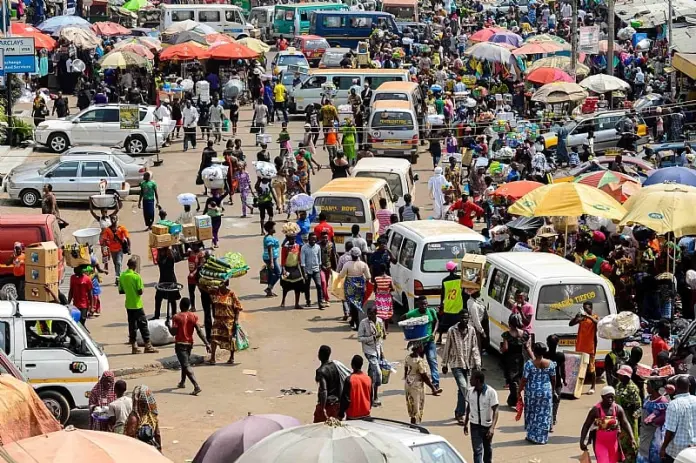Ghana’s economy continues to chart a path of steady expansion despite mounting structural challenges, recording a 4.5% growth in July 2025, according to the latest data from the Ghana Statistical Service (GSS).
The Monthly Indicator of Economic Growth (MIEG), released by the GSS, highlights strong performances in the services and agriculture sectors, even as the industrial sector faltered significantly.
The 4.5% growth rate recorded in July 2025 represents a moderation compared to the 8.3% recorded in the same period last year. While this signals a slowdown in overall economic activity, it also reflects the economy’s underlying resilience amid fiscal consolidation efforts and global headwinds.
Speaking at a media briefing, the Government Statistician, Dr. Alhassan Iddrisu, explained that the newly introduced Monthly Indicator of Economic Growth (MIEG) serves as a high-frequency measure of Ghana’s economic performance.
The indicator, modeled on the framework of quarterly GDP data, is designed to track short-term changes in economic activity, thereby providing timely insights for policymakers and investors. “The economy continued to expand in July 2025, though at a slower rate compared to the same period last year,” Dr. Iddrisu stated.
The MIEG provides a crucial early signal on the direction of the economy, supporting evidence-based policy and investment decisions.
According to him, the slowdown in overall growth underscores the need for continued reforms to stimulate industrial output and sustain broad-based recovery across sectors.
Services Sector Remains the Backbone of Growth
The services sector once again proved to be the powerhouse of Ghana’s economy, maintaining its strong momentum and consolidating its dominance in the country’s economic structure. The data revealed that the services sector grew by 6.4% in July 2025, an improvement from the 4.5% growth recorded in July 2024.
This impressive performance contributed a substantial 58.4% to the overall MIEG growth, reinforcing the sector’s role as the engine driving Ghana’s economic expansion.
The growth in services was largely supported by activities in information and communication technology, trade, transport, and financial services. These sub-sectors benefited from increased digital adoption, stronger consumer spending, and enhanced efficiency in financial transactions.
Analysts suggest that the continued expansion of services reflects the structural shift in Ghana’s economy toward a more diversified and technology-driven framework. However, they caution that excessive dependence on services without corresponding growth in industrial production could expose the economy to external shocks and limit job creation.
Agriculture Posts Remarkable Rebound
One of the bright spots in the latest GSS report is the agriculture sector, which posted a robust 8.0% growth in July 2025—an impressive recovery from the modest 2.4% recorded in July 2024.
The rebound was attributed to increased output and productivity in crop and livestock production, aided by favorable weather conditions and improved access to farming inputs. Agriculture contributed 37.1% of the total MIEG growth, underscoring its vital role in supporting food security and rural livelihoods.
Government initiatives such as the Planting for Food and Jobs (Phase II) and renewed investments in irrigation and mechanization have also helped enhance productivity and reduce post-harvest losses. Meanwhile, the sharp rebound in agriculture is an encouraging sign, Dr. Iddrisu emphasized.
Again, it shows that the sector remains resilient and capable of driving inclusive growth when supported by the right policies.
Industry Falters Amid High Costs and Weak Demand
In stark contrast to the buoyant services and agriculture sectors, Ghana’s industrial sector struggled in July 2025, recording a marginal growth of just 0.1%, a steep decline from 17.7% in July 2024.
The slowdown was driven largely by weak performance in manufacturing and construction, which continue to grapple with high production costs, energy constraints, and reduced external demand. The sector’s contribution to overall growth stood at just 0.9%, reflecting a concerning stagnation in one of the key pillars of long-term economic transformation.
The GSS highlighted that the persistent challenges in industry reveal the structural vulnerabilities of Ghana’s industrial base. These include overreliance on imported raw materials, limited value addition, and insufficient investment in technology and infrastructure.
Economic analysts have warned that unless urgent steps are taken to revitalize industry through targeted incentives, energy reforms, and lower financing costs, Ghana’s industrialization agenda could face setbacks.
The introduction of the Monthly Indicator of Economic Growth marks a significant step forward in Ghana’s economic data management. The GSS believes the MIEG will serve as a vital early-warning tool for detecting shifts in economic activity and guiding responsive policy interventions.
By offering monthly updates instead of waiting for quarterly GDP releases, the MIEG enhances the timeliness and precision of economic monitoring, especially in a rapidly changing global environment.
Dr. Iddrisu noted that with consistent data collection and transparent reporting, the MIEG will help both government and private sector stakeholders to make better-informed decisions, track policy outcomes, and anticipate emerging risks.
While the 4.5% growth recorded in July 2025 reflects sustained expansion, the uneven performance across sectors underscores the need for balanced and inclusive growth strategies.
Experts believe that reviving the industrial sector remains critical to ensuring long-term resilience, job creation, and export diversification. Strengthening linkages between agriculture and industry, promoting local manufacturing, and enhancing competitiveness through technology and innovation are key steps toward achieving this goal.
READ ALSO: NPP Flagbearer Aspirants Urged to Focus on Real Issues, Responsible Leadership























